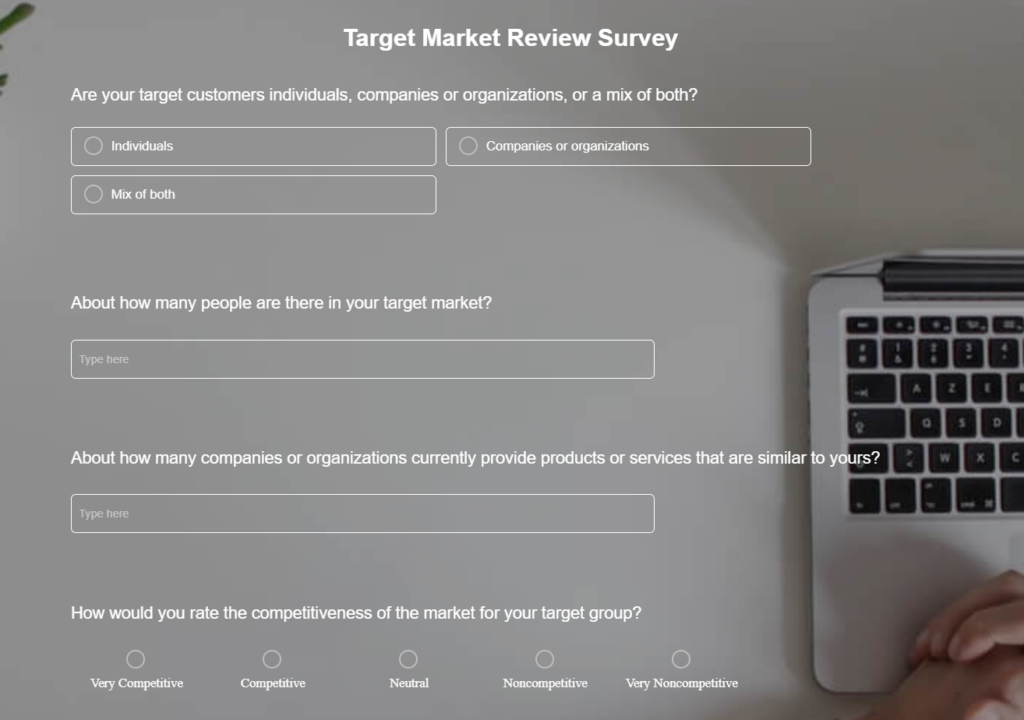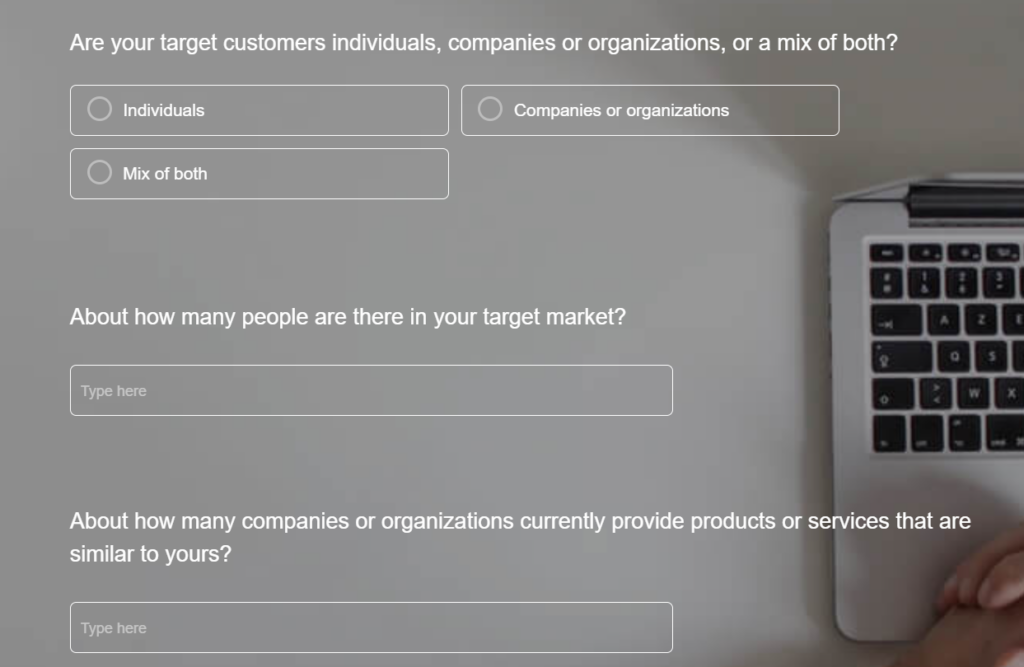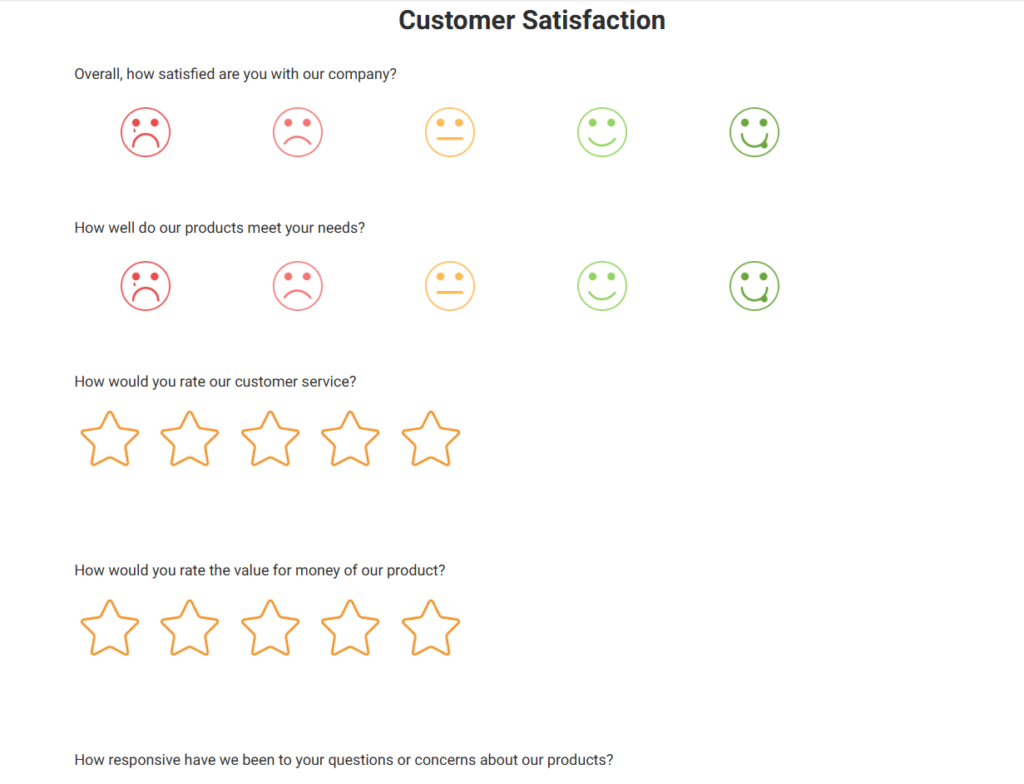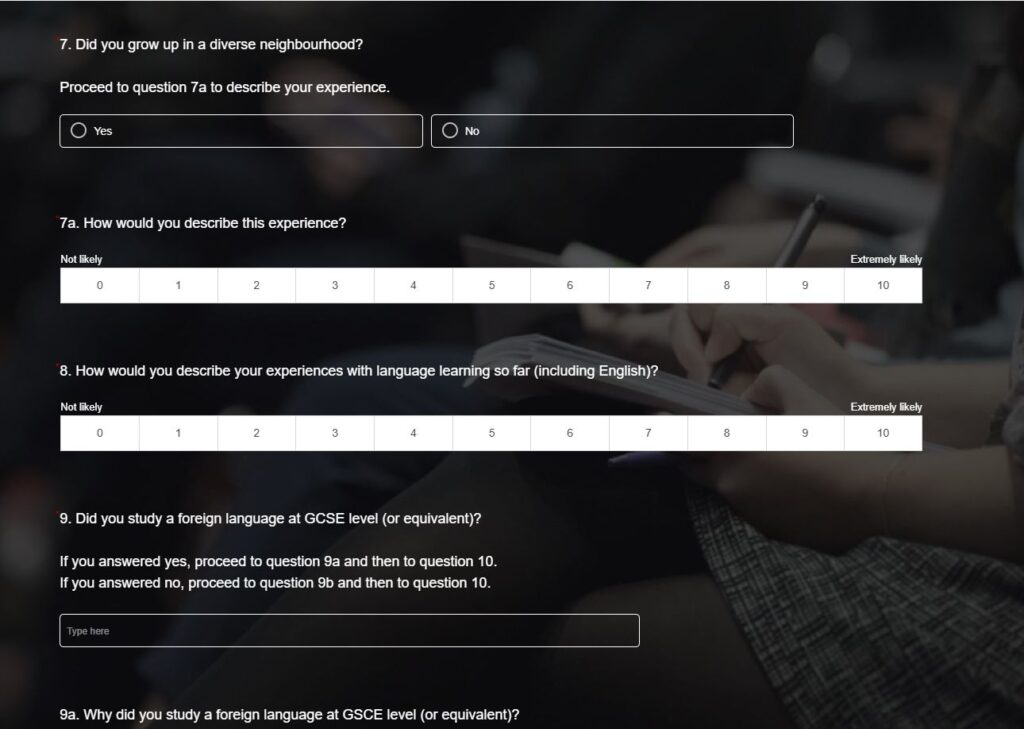Did you know that “survey” and “questionnaire” aren’t as interchangeable as generally perceived? While the terms are often used synonymously, there’s a subtle but important difference.
Before you make a questionnaire, it’s crucial to understand this: a survey is the overall process of gathering information, while a questionnaire is the tool used within that process—the actual set of questions you ask.
And let’s be honest, crafting a truly effective questionnaire can be tricky. We’ve all experienced the frustration of low response rates, confusing answers, and data that doesn’t give us the necessary insights.
But it doesn’t have to be that way! In this blog, I’ll walk you through every step of structuring your questionnaire for maximum impact.
What Is a Questionnaire?
What Is a Questionnaire?
Simply put, a questionnaire is a tool for gathering information from people. It’s a set of questions designed to elicit responses that help you understand a topic, make informed decisions, or conduct research.
Think of all the times you’ve filled out a form, answered a survey, or taken a quiz – those are all types of questionnaires! They have widespread applications, from market research and customer feedback to academic studies and employee evaluations.

Now, not all questionnaires look the same. Some are highly structured and have a predetermined set of answers, while others are more open-ended and allow for free-form responses.
The best type of questionnaire for you will depend on your specific goals and the information you want to gather.
Types of Questionnaires and Their Purposes
Using the right questionnaire is like choosing the right tool for a job. Each type is designed to fulfill a specific purpose, whether you need quick, comparable data or rich, detailed insights. Here’s a closer look at the most common types of questionnaires and how they’re used.
1. Structured Questionnaires
Structured questionnaires are built with a fixed set of questions and limited answer choices, such as multiple-choice, rating scales, or rankings. These are ideal when you need data that is easy to analyze and compare across a large group.
When to Use: These are best for large-scale studies, customer satisfaction surveys, employee feedback, or any research that needs quantifiable results.
Strengths:
- Quick and Efficient: Respondents can complete them quickly, and the data is simple to process and analyze.
- Consistency Across Responses: Since everyone answers the same questions in the same format, it’s easy to compare responses across demographics or groups.
- Objective Results: By limiting answers, structured questionnaires minimize bias and allow for neutral, standardized data collection.
Weaknesses:
- Shallow Insights: The limited format doesn’t leave room for respondents to explain their opinions or provide detailed feedback.
- Potential Bias: Predefined answer choices might not fully represent a respondent’s true feelings, which can skew results.
Example Use Case: A company conducting an annual employee satisfaction survey to track trends and identify areas for improvement.
2. Unstructured Questionnaires
Unstructured questionnaires rely on open-ended questions, allowing respondents to answer in their own words. This method is perfect when you’re looking to gather detailed, qualitative insights that go beyond surface-level data.
When to Use: Best for exploring complex topics, understanding motivations, or gaining insight into attitudes, opinions, or behaviors. It is commonly used in interviews or exploratory research.
Strengths:
- Rich, Detailed Responses: Open-ended questions let respondents share their thoughts fully, providing deeper insights into their experiences or beliefs.
- Flexible and Adaptive: Respondents can take their answers in unexpected directions, which can uncover insights you hadn’t considered.
- Great for Discovery: Ideal for brainstorming or forming new theories based on what respondents share.
Weaknesses:
- Time-Consuming Analysis: Sorting through and interpreting open-ended responses takes significantly more time and effort compared to structured data.
- Subjectivity in Responses: Open-ended questions can lead to subjective answers, and analyzing them can introduce interpretation bias.
- Lower Participation Rates: Open-ended questions require more effort from respondents, which may lead to fewer completed responses.
Example Use Case: A nonprofit conducting interviews to understand why some donors stop contributing to their campaigns.
3. Semi-structured Questionnaires
Semi-structured questionnaires combine elements of both structured and unstructured formats. They offer the precision of closed questions with the flexibility of open-ended ones, making them suitable for studies that need both statistical data and in-depth feedback.
When to Use: Use these when you want both quantitative data (e.g., numerical ratings) and qualitative insights (e.g., personal opinions). They are great for mixed-method research and mid-sized surveys.
Strengths:
- Versatility: They adapt to a wide range of research goals, providing a mix of numbers and detailed opinions.
- Balanced Insights: The combination of structured and unstructured questions ensures you get both measurable data and rich qualitative feedback.
- Encourages Nuanced Feedback: Open-ended options allow respondents to elaborate when necessary without overwhelming them with too many open-ended questions.
Weaknesses:
- Design Complexity: Crafting a semi-structured questionnaire takes careful planning to ensure the questions flow logically and balance the two formats.
- Challenging Analysis: While structured responses are easy to analyze, interpreting open-ended responses alongside them can make data processing more complicated.
- Time-Consuming for Respondents: Mixing question types may take longer to complete than purely structured surveys, potentially affecting completion rates.
Example Use Case: A retailer surveying customers about a recent product launch, including both satisfaction ratings and feedback on what they liked or didn’t like.
💡A Quick Overview of How to Choose the Right Type:
|
By selecting the right type, you’ll collect better data and ensure the questionnaire aligns with your research goals.
How to Make a Questionnaire in Simple Steps
Here are the key steps to keep in mind when learning how to make a questionnaire.
Remember that every step matters. Skipping even one detail could mean missing out on valuable information that might be critical for achieving your goal—like launching a successful marketing campaign.
1. Selecting a Survey Tool
Questionnaires can be sent online or offline, but offline surveys can be cumbersome and can be difficult to carry out. For that reason, creating your questionnaire via an online survey tool is best. Respondents receive the questionnaire via mail, through social media, or find it on the company’s website and can fill it out at their convenience.
ProProfs Survey Maker is one such tool that you can use. It’s easy to use and lets you make a questionnaire online free. Features like an AI survey generator, prebuilt templates, readymade questions, customization options, and a wide array of sharing options make the process hassle-free and quick.
How to Create Engaging Surveys Online with ProProfs Survey Maker – Free & Easy
2. Choosing Your Questions
When it comes to drafting questions, it’s easy to get carried away and ask anything and everything that comes to mind. Don’t make this mistake—it’s one of the quickest ways to lose focus.
The first step is to be clear about your purpose. Ask yourself: “What do I really want to know?” Once you define your goals, focus only on the questions that help you achieve them and leave out anything irrelevant.
The questionnaire can include both open-ended and closed-ended questions. However, there is an important distinction between these types of questions and the kind of information they will fetch.
- Closed-ended questions: These are the questions that can be answered with a simple “yes” or “no” by choosing one of the response options provided in the questionnaire, e.g., A, B, C, or D.
Examples of closed-ended questions are:
“Does your product or service require repeated payments?
“Did you like the product/service offered by (company name)?”
- Open-ended questions: These are statement questions that require the respondent to answer in more than one word, probably a statement or two to three sentences. Companies commonly use open-ended questions to get user feedback on their product/service.
They often begin with words like why, what, how, describe, explain, what do you think about, tell me about, etc. This will require the respondent to think profoundly and answer the question in their own words.
Examples of open-ended questions are:
“Tell us about your experience at the exhibition.”
“How could we have exceeded your expectations?”
The survey questions can be further divided into different categories:
- Rating Scale: In this type of question, the respondent is asked to rate different items on a scale of 0-10 or give a star rating. This type of question is beneficial for measuring customer satisfaction levels.
- Multiple-choice Question: In multiple-choice questions, the respondents are given certain answer choices for a particular question. Respondents can choose a single answer of more than one, per their requirement and preference.
- Likert Scale: A Likert scale is a common choice for survey forms and a great way to know what respondents feel about something. Respondents are given 5-7 balanced answer choices with neutral midpoints. The answer choices can be very satisfied, satisfied, neutral, unsatisfied, or very unsatisfied.
| Questions to Avoid
❌ Biased questions: When creating a questionnaire, ensure the questions are unbiased or neutral. Don’t predispose the respondent to accept a particular answer as their own choice. 🛑 Example: Don’t you think our product is the best on the market? ✅ Better: How would you rate our product compared to others on the market? ❌ Leading questions: Leading questions are strategically written using emotional phrases to manipulate the respondent to give answers in a particular way. These questions are highly prohibited during qualitative or quantitative survey research. 🛑 Example: Don’t you agree that our customer service team is incredibly helpful? ✅ Better: How would you describe your experience with our customer service team? ❌ Compound or Double-Barreled questions: A double-barreled question asks respondents two questions in a single survey question while allowing only one answer. In addition to research, these attitudinal questions are often used in court to trick witnesses or suspects or during cross-examination. 🛑 Example: Do you agree that our product is affordable and easy to use? ✅ Better: 1. Do you think our product is affordable? 2. Do you find our product easy to use? |
3. Selecting the Right Mode of Questionnaire
Survey questionnaires are fruitful when you choose the right platform to field the survey.
Questionnaires can be used for data collection in several ways, which are:
- Face-to-face interview
- Telephonic interview
- Self-completion of a paper questionnaire
- Self-completion of an online questionnaire
Self-completion of paper questionnaires is commonly used to collect massive amounts of information from a large population in a relatively short time. They are specifically designed to collect the data from the respondent without any intervention from the surveyor. Moreover, you have no control over the response rate and time, the accuracy of the information, and survey completion.
In face-to-face and telephone interviews, the interviewer can explain the questions and clarify misunderstandings. They can also check for inconsistencies and errors on the spot. The best part is that they ensure all the questions are answered. Due to quick feedback, interviewers can make immediate corrections to the questionnaire, making it more respondent-friendly.
However, this form of questionnaire has a long list of disadvantages:
- Interviewer fatigue
- Interviewer bias
- Expensive
- A time-consuming training process
- Interviewers may influence the respondent
4. Designing Your Questionnaire
Once your questions are ready and the mode of distribution is chosen, it’s time to design the questionnaire.
A questionnaire doesn’t need to be flashy, but it should be visually appealing to grab attention. Keep the design simple yet attractive:
- Use easy-to-read fonts and a clean layout.
- If possible, include all questions on one page. This avoids surprising respondents with additional pages and keeps them engaged.
- Limit the number of questions to 8-10, ensuring it takes no more than 5 minutes to complete. If you must include more, consider offering incentives (e.g., discounts) to motivate respondents.
5. Ordering Your Questions
Now that you have created the questions and selected the questionnaire mode best suited to your survey needs, it’s time to focus on the questionnaire’s design.
A questionnaire needn’t be state-of-the-art, but it must have a visually appealing design to get the respondent’s attention. Keep it minimalistic. Choose simple and easy-to-read fonts and text sizes for your questions, placed on an attractive background.
Fit all the questions on a single page. This will prepare the customers for everything before them, with no surprises. If you have to ask more questions, offer respondents an incentive to complete the questionnaire.
The next important step is order. A good questionnaire structure is vital for higher completion rates.
For example, let’s say you start a questionnaire with a simple “yes/no” question like, “Do you buy our product?” and then immediately hit them with two open-ended questions that require paragraphs of writing.
What do you think will happen? Most likely, they’ll close the survey and say they’ll finish it “later”—which often means “never”!
Why? Because you’ve created a jarring experience. It’s like starting a casual conversation and suddenly demanding a deep philosophical debate. People need time to warm up!
To overcome this, use a funnel approach. First, give the respondents a nice warm-up with easy closed-ended questions, making them comfortable with the survey topic, and keep complex or open-ended questions for later.
Questionnaire Templates
Here are some questionnaire templates with the most asked questions that you can include in your questionnaires.
1. Target Market Review Survey Template

2. Employee Engagement Survey Template

3. Customer Satisfaction Survey Template

4. Student Survey Template

5. Event Feedback Survey Template

FREE. All Features. FOREVER!
Try our Forever FREE account with all premium features!
How to Analyze Questionnaire Data
Analyzing questionnaire data can seem daunting, but with a systematic approach, you can unlock valuable insights and make data-driven decisions. Here’s a step-by-step guide to help you navigate the process:
- Data Preparation:
- Clean the data: Check for any errors, inconsistencies, or missing values. Clean and organize the data to ensure accuracy.
- Code open-ended responses: If you have open-ended questions, categorize and code the responses to facilitate analysis.
- Quantitative Data Analysis:
- Descriptive statistics: Calculate measures like mean, median, mode, and standard deviation to understand the distribution of your data.
- Charts and graphs: Visualize your data using charts and graphs (e.g., bar charts, pie charts, histograms) to identify trends and patterns.
- Inferential statistics: Use statistical tests (e.g., t-tests, chi-square tests) to draw conclusions about your population based on your sample data.
- Qualitative Data Analysis:
- Thematic analysis: Identify recurring themes and patterns in the responses to open-ended questions.
- Content analysis: Analyze the content of the responses to identify key concepts, ideas, and sentiments.
- Narrative analysis: Explore the stories and narratives that emerge from the responses.
- Interpretation and Reporting:
- Draw conclusions: Based on your analysis, draw conclusions about your research questions and objectives.
- Identify key findings: Highlight the most important and relevant findings from your data.
- Create a report: Present your findings in a clear and concise report, using visuals to aid understanding.
Tools and Resources:
- Spreadsheet software: Use spreadsheet software like Microsoft Excel or Google Sheets for basic data analysis and visualization.
- Statistical software: For more advanced analysis, consider using statistical software like SPSS or R.
- Qualitative data analysis software: Explore software like NVivo or Atlas.ti to help with qualitative data analysis.
By following these steps and utilizing the appropriate tools, you can effectively analyze your questionnaire data and gain valuable insights to inform your decision-making.
Best Practices to Follow for Effective Questionnaires
Here are some tips to create a questionnaire that will get you more responses as well as the information you seek.
- Use Simple, Clear Language
Avoid complex or technical jargon that might confuse respondents. Keep your questions straightforward, conversational, and easy to understand. - Steer Clear of Hypotheticals
Refrain from starting questions with phrases like “Imagine you have…” as they can lead to vague or speculative responses. Focus on real experiences or opinions instead. - Stay Neutral
Don’t inject personal opinions or judgments into your questions. This ensures you collect unbiased and authentic responses. - Avoid Extreme Wording
Words like “right,” “wrong,” “love,” or “hate” can influence responses and skew results. Instead, use neutral language to keep the question balanced. - Handle Sensitive Topics Carefully
Be extra thoughtful when addressing sensitive issues. Frame such questions in a way that feels respectful and non-invasive to the respondent. - Focus on One Topic per Question
Ensure each question covers only one idea or subject. This eliminates confusion and makes it easier for respondents to provide accurate answers. - Consider Your Audience
Tailor your questions to the social, cultural, and educational backgrounds of your respondents. This helps ensure inclusivity and relevance. - Avoid Double-Barreled Questions
Break down compound questions into two separate ones. Asking multiple things at once can confuse respondents and compromise the quality of your data.
Create Highly Engaging Questionnaires to Gain Deeper Insights
Questionnaires are an invaluable way to collect a wide range of information from the respondents. But without requisite questionnaire construction, your efforts might go in vain.
Thoughtfully written questions with proper questionnaire format and appealing presentation, conducted through the right platform can make the questionnaire worthwhile. Be smart and keep the right survey questionnaire tool handy to capture the intended information from the audience whenever you want.
You can try ProProfs Survey Maker and create unlimited questionnaires for free. The tool offers features like 100+ ready-made templates, an AI survey generator, 1,000,000+ survey questions, robust security, extensive customization options, and easy sharing, which makes it perfect for questionnaires of all types!
Get a demo or get started free today!
 Tips
Tips
We’d love to hear your tips & suggestions on this article!
FREE. All Features. FOREVER!
Try our Forever FREE account with all premium features!


 We'd love your feedback!
We'd love your feedback! Thanks for your feedback!
Thanks for your feedback!







